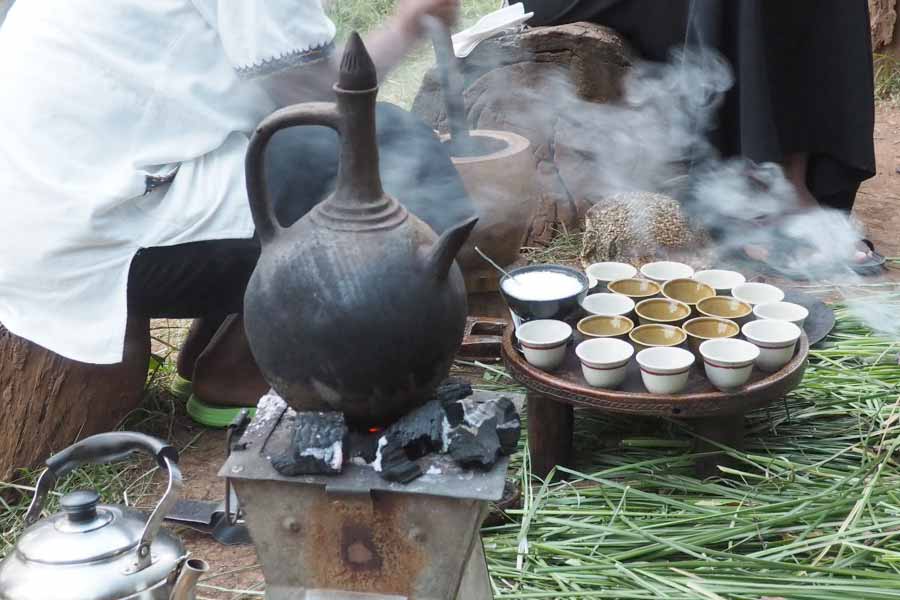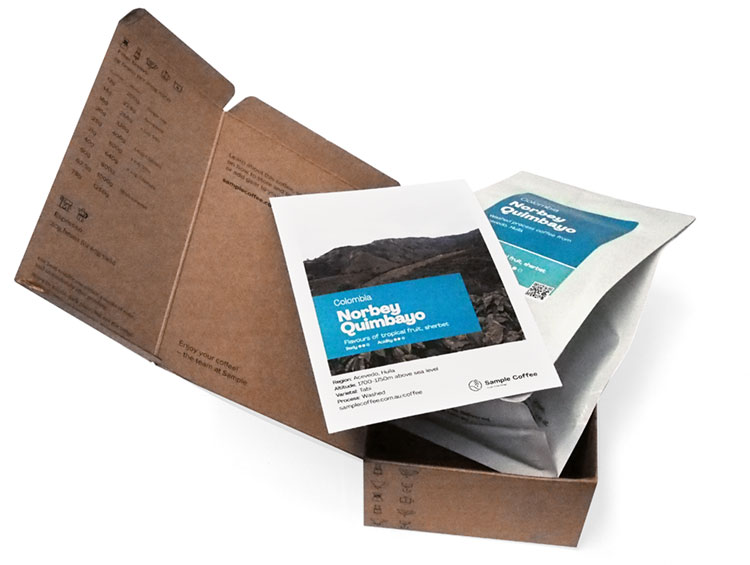-
Country
- Ethiopia
-
Region
-
Yirgacheffe
-
Altitude
-
2000 – 2350m above sea level
-
Variety
-
Process
-
Harvested
-
December 2015
-
Importer
-
Cafe Imports
-
Body
-
Light
-
Acidity
-
Bright
-
Tasting notes
-
Peach, orange blossom, bergamot
-
Roast style
Ethiopia
Beriti
Welcome to the first of the fresh harvests from Ethiopia!
Reuben visited Ethiopia at the end of last year, visiting farms and washing stations, along with the ECX (Ethiopian Coffee Exchange) where coffee crops are traded.
Ethiopia’s the birthplace of coffee, and the coffee you’re drinking is Ethiopian Heirloom varietal, which is a mix of the naturally-occuring varietals of the region. If you look closely at the beans you’ll possibly notice more variation in the size than with other single origins, which are quite often a single varietal.
Jebena Buna: Ethiopian coffee ceremony
It’s not surprising that a country like Ethiopia also has long and rich traditions around drinking coffee, and their coffee ceremony is the perfect example. Here’s a photo of coffee being prepared during Reuben’s visit:
Much like here, coffee has a strong element of social bonding to it: the ceremony is about getting people together to talk.
Unlike here, they start with green beans and roast them right before brewing (we recommend giving our beans at least three days between roasting and brewing). They’re typically roasted in a frying pan over a flame, and often carried around afterwards to help cool the beans and also share the aromas with others nearby.
After grinding the beans in a mortar and pestle, they’re brewed in an unusual vessel: a long-necked ceramic kettle called a jebena. When the coffee boils up through the top of the container, it’s poured in and out of another container to cool it, then back into the jebena for serving.
 Jebena
Jebena
Small serving cups without handles are arranged on a tray, and the coffee is served in a continuous pour from cup to cup until they’ll all full. Traditionally the youngest child of the family will serve the coffees, with the eldest person in the room served first.
This is repeated with the same coffee grounds three times by adding fresh water: the first is called Arbol in Amharic, followed by the second,Tona, and finally the Bereka, which is also considered to be a blessing.
The way coffee is roasted and served in Ethiopia means this coffee is typically dark and bitter compared to the lighter roast that you’re drinking, so it’s also usually sweetened with sugar.
Vice Munchies capture the experience of the coffee ceremony in Addis Ababa, or Saveur magazine filmed the Ethiopian coffee ceremony if you’d like to see this in action:
And now, some jazz
One other indelible side to Ethiopia is their vibrant live jazz scene: it's one of Reuben’s highlights from the visit last year.
This 45-minute mix comes from MogaDisco, a group of four collectors of African music, and gives you a taste of the range of music coming out of Ethiopia.
Learn everything about this coffee:
Ethical, traceable sourcing
This page has all the sourcing information (variety, process, region, story, importer, and more) that our importers share with us, and give us permission to use.
The transparency helps us talk confidently about the quality and background of our product, and it helps you know exactly what you’re buying.
Learn more:
Coffee page transparency legend
Our coffee philosophy
Our business approach
Fresh harvest coffee
We only source and roast coffee from each country’s latest harvest season (so the green coffee is never older than 1 year from the time of picking, processing and packing). This ensures the sensory qualities are always at their peak and unaffected by excessive ageing.
Roasted for espresso and filter (best enjoyed black)
Roast style: omni. Omni roasts are designed to brew and taste great both as espresso and filter. Our omni single origins generally sit on Agtron values in the ~70-60 value range. So, technically, they are somewhere in the lighter side of the medium spectrum.
Designed for espresso and filter brewing. Best enjoyed black.
Learn more:
Our Loring Kestrel S35 roaster
Our roasting style and approach
Best brewed within days 15-49 post-roast
The ‘fresh is best’ saying doesn’t apply to coffee (contrary to popular belief). Waiting before opening and brewing your bag of whole coffee beans helps develop peak flavour and acidity.
But heads up: if you buy pre-ground coffee, brew it as soon as possible.
Learn more:
Our recommended brewing window
Try our custom brewing recipes
Our recipes and ratios are tailored to our coffee sourcing and roasting styles, bringing the best flavour and feel out of each coffee.
For pour over, immersion, and other filter brewing styles, check our brew guides.
For our espresso single origins, we recommend a coffee:yield ratio of 1:3:
- Dose: 20g ground coffee
- Yield: 60g espresso
- Total brew time: ~24-28 seconds
This is just a starting point! We encourage you to experiment, taste, and adjust to find the recipe that you enjoy the most.
Learn more:
Our espresso brew guide (single origin)
Brewing ratio calculator
Packaging and sustainability
- Bags: ABA-certified home compostable (AS 5810-2010)
- Labels: recyclable
- Valves (only on +250g bags): general waste
- Box and tape (online orders): recyclable
Learn more:
Our packaging
Variety
Ethiopian Heirloom variety
Heirloom (or sometimes Landrace) is an umbrella term that refers to all the coffee varietals endemic to Ethiopia.
The location
Coffee from Ethiopia
Seen as the birthplace of domesticated coffee, there are not many more exciting times at the Sample warehouse as when our fresh Ethiopian lots arrive. Legend says it’s our favourite origin…
The Yirgacheffe region of Ethiopia
Unique for its floral and highly aromatic coffees. Some our of very favourite and memorable Ethiopian coffees have emerged from this legendary region.
Farm processes
Washed process
Machines are used to remove the flesh from the coffee cherry before being fermented in water, washed again, and finally sun dried. This process tends to result in more distinct, cleaner flavours.
1 brew note from subscribers
Ethiopia Beriti
Jared’s V60
Absolute stunner. Really getting the orange notes. Loving this one.

Subscribe to a world of coffee
Discover a new single origin coffee from Sample every 1-5 weeks with no delivery fees.
No up-front purchase, and you can pause, cancel, or change plans at any time.
Available to order online this week:

Nicaragua Guillermo Montenegro
Flavours of plum, nectarine, shortbread
Body Acidity
Washed Caturra
March 2025 harvest
Roasted omni for filter and espresso
Nicaragua Guillermo Montenegro online
Ethiopia Bekele Gemeda
Flavours of mandarin, white peach, mango
Body Acidity
Washed Ethiopian Heirloom
November 2024 harvest
Roasted omni for filter and espresso
Ethiopia Bekele Gemeda online
Ethiopia Laba Gesha
Flavours of black tea, cherry, prune
Body Acidity
Natural Kurume
February 2025 harvest
Roasted omni for filter and espresso
Ethiopia Laba Gesha online
Colombia Carlos Imbachi Pink Bourbon
Flavours of pear, jasmine, sugarcane
Body Acidity
Washed Pink Bourbon
February 2025 harvest
Roasted omni for filter and espresso
Colombia Carlos Imbachi Pink Bourbon online